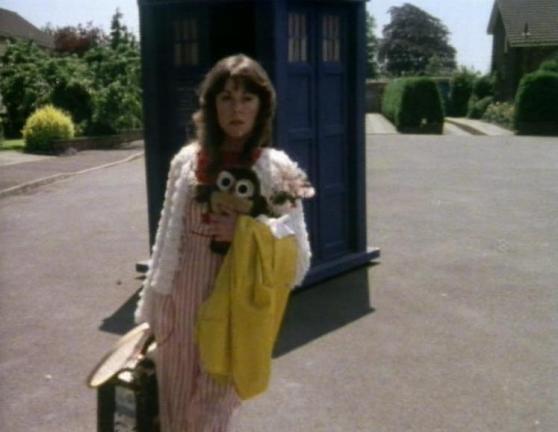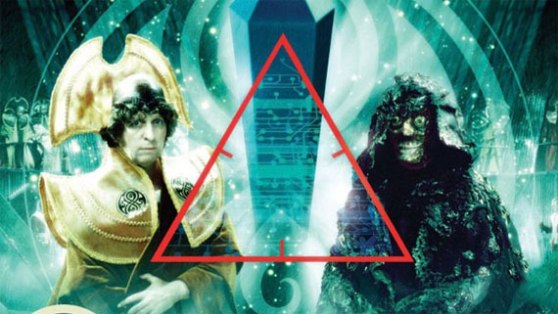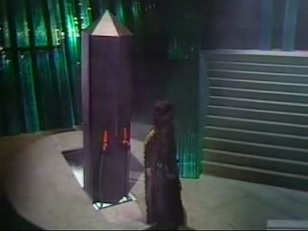We’re back, with our rewatch of Classic Doctor Who! We’re at Season Fourteen this week, with the Fourth Doctor and Sarah Jane Smith. I’ve decided, against my usual policy, to split this season’s rewatch into two parts, but not for the same reason as with the lengthy Season Three. Rather, after dealing with an unexpected illness this week, I am, simply, running behind. As I want to post each week, I think it’s best to split this season, in case I haven’t finished it by the end of the week. It’s a good time, however, and for a number of reasons: For one, the third serial, The Deadly Assassin, is heavy on new information, and deserves a closer look. For another, we’ll have a gap between companions at that point, which is significant for being one of the few places that spinoff stories can be inserted into the Fourth Doctor’s tenure without difficulty. And for a third, even the original broadcast took a break midway through the season, billing the fourth serial onward as a new series (though that terminology was later dropped). So, with all that said, let’s get to it!

The TARDIS goes retro?
We open with the Doctor and Sarah exploring the TARDIS in The Masque of Mandragora. It’s historically significant; it’s our first real view of parts of the TARDIS that we have never seen before. It introduces the notion that the TARDIS doesn’t have a defined interior volume—that it can and does change in both size and configuration—but that it is at the least vast. It also introduces a secondary control room, which will be used in place of the primary one for a time, and sets the groundwork for the much-later revelation that the TARDIS archives all its old control rooms (The Doctor’s Wife). It’s a beautiful wood-paneled set, though it has not always been universally loved by fans; interestingly, it has no time rotor of any sort, the only control room we’ve ever seen that lacked one. We find that the Doctor has been here before, and even used it before, in offscreen appearances; some of his past lives’ accoutrements are here. We see as well—though it’s not spelled out—that any active control room will be connected to the main exit.

No, not THAT famous event in 1492.
Being pulled to Earth, the time travellers find themselves in 1492, San Martino, Italy, making this a pseudohistorical serial. They are brought here by the Mandragora Helix, a living spiral of energy encountered in the time vortex, which the doctor has encountered before, though not by name. In turn they carry it to Earth, where it begins a mission of conquest and eradication, using the evil astrologer Hieronymous as a host. The Doctor eventually defeats the Helix by turning its energy against itself, essentially cancelling itself out, though it is not destroyed; it will return again in several centuries.

Giuliano and Marco
We’re first introduced to the notion that the TARDIS translates for its passengers. The Doctor claims credit for it, calling it a gift of the Time Lords which he allows his companions to share. Both seem to be true; both the Doctor and the TARDIS must be “in the circuit” for it to work, as seen in The Christmas Invasion when the Doctor’s post-regenerative coma prevents translation. We also get another glimpse of the Doctor’s swordsmanship. The supporting characters of Giuliano and Marco certainly give the appearance of being a gay couple, though that is never stated; if that is the intention (and I could find nothing definite about it), it would have been a risqué move at the time, especially as they are taken quite seriously in the story.

Don’t be sad, Sarah Jane. You’ll see him again…and again…and again…
After more than three seasons, we say goodbye to Sarah Jane Smith in The Hand of Fear. Actress Elizabeth Sladen actually extended her contract specifically for this serial, and it’s not hard to see why; it’s a good, tight story, and one that gave Sarah’s character considerable range, though many of her actions were carried out under mind control by the villain of the story. The story is probably contemporary with its broadcast, though it’s hard to be sure; certainly it is in the late seventies at least, and before the events of 1981’s failed spinoff K9 and Company, which features Sarah Jane. It’s made less clear because she is not seen to have been particularly missed; without a steady, accountable job such as that of Ian and Barbara, and without many close connections, there’s no indication of her having been reported missing or any such involvement. The Doctor does show considerable honest, non-sarcastic concern for her when she is hurt, and again when it’s time for her to leave; in keeping with my theory that this is the Doctor’s “rebellious teen phase”, I’d say we’re starting to see some growth in him.

Eldrad and…Eldrad?!
Eldrad, of Kastria, is an interesting villain: silicon-based, able to survive in fragmentary form for millions of years, and able to be revived after long periods. His people, the Kastrians, are a sort of mirror of the Time Lords, even; they are able to regenerate, after a fashion, and even change genders while doing so, presaging the Time Lords’ ability to do so by nearly forty broadcast years. Unlike the Time Lords, they require outside energy in the form of radiation to do so. Also, they chose mass suicide rather than face the possibility of rule by Eldrad, which I find to be a rather extreme reaction. Eldrad at one point asks the Doctor to take him back to his own past, which the doctor states would contravene the First Law of Time; this is, as far as I can tell, the first reference to that law.

Goodbye, Sarah Jane.
In the end, the Doctor is again summoned to Gallifrey by the Time Lords. It’s not specifically stated here that non-Gallifreyans can’t go there; however, the Doctor says he can’t take Sarah there, implying it is at least not safe for her. To her chagrin—but also, to some degree, to her happiness—he returns Sarah home. Of course, being the Doctor, he misses the mark; we’ll eventually learn in School Reunion that he dropped her in Aberdeen, Scotland, instead of her home in South Croydon.

The Doctor, framed!
The Deadly Assassin is unique among all other serials, for several reasons. Most notably, it’s the ONLY full-scale companion-free story in all of televised Doctor Who. (Fans may point out Midnight and Heaven Sent, but in those stories, the Doctor at least HAD a companion who could not be present. Here he has none. Mini-episodes Time Crash and The Night of the Doctor briefly include Martha Jones and pseudo-companion Cass.) It’s also the only time the entire cast is of one species, namely, Gallifreyan. We get a rare opening voiceover by the Doctor, about the Time Lords and Gallifrey. The Master returns in his first appearance since the death of Roger Delgado three years earlier; here he is played by Peter Pratt in a much decayed form. It’s never stated, but has been commonly accepted that this is the same form as Delgado’s Master, having suffered some trauma. Dating this serial is impossible; we only know that it is after “309906”, the date given for the Second Doctor’s trial in The War Games.

The Eye of Harmony
This episode is full of “firsts”, mostly with regard to the Time Lords and Gallifrey. It’s a lot to discuss, so, in list form, we see:
- The Matrix and the APC Net (related, but not the same).
- Rassilon (not alive at this time, but mentioned).
- The Eye of Harmony, said to be below the capital. The version we see is probably an interface for the actual Eye, as it differs greatly from the versions we see in Journey to the Center of the TARDIS and the 1996 movie.
- Time Lord formal attire.
- The Seal of Rassilon—we’ve seen it before, but in conjunction with the Cybermen.
- Cardinal Borusa, the Doctor’s old teacher-turned-politician.
- The office of Lord President and its accoutrements.
- The twelve-regeneration limit is first mentioned.
- The Gallifreyan Chapters, the Doctor being of the Prydonian chapter.
- Transduction—a form of transmat—and the transduction barriers.
- Stasers, personal weapons which appear to prevent regeneration when they kill.
- The Capitol or Citadel and the Panopticon, with their distinctive guards.
- The Old Times.
- The Celestial Intervention Agency, or “CIA”.
- The Doctor’s TARDIS is first referred to as a Type 40.
- The Doctor loses his hat, or headdress in this case…wait, no, that’s nowhere near a first for the Fourth Doctor, he does that in nearly every story.

Cardinal Borusa
The Time Lords, oddly, don’t seem to know anything about the Master. While his biodata was purged from the APC Net, you’d think someone would know the guy, especially as the Time Lords warned the Third Doctor of his arrival on Earth in Terror of the Autons. We can perhaps forgive some forgetfulness, however; in their own environment, the Time Lords prove they can be quite petty and human. Technically, the Doctor becomes Lord President in this story; he claims candidacy as a ploy to save himself from execution, and then his only competitor, Goth, proves to be the titular assassin and is killed. However, the Doctor won’t assume the role until a later adventure (Season Fifteen’s The Invasion of Time); he leaves the Time Lords in the hands of the rather oily, shrewd, and—in my opinion—untrustworthy Borusa. As he escapes at the end, the Master does also, free in the universe with another TARDIS. Overall, it’s a good serial, and sets the tone for Gallifrey for years to come.
Next time: A new companion! See you there.
All episodes can be viewed on Dailymotion; links are below.

